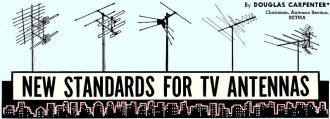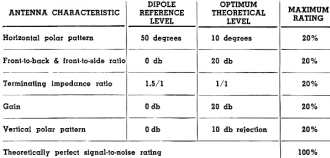New Standards for TV Antennas |
||
The RETMA referenced in this 1954 Radio & Television News magazine article entitled "New Standards for TV Antennas" was commonly known back in the day, but not many would recognize it nowadays. RETMA, founded in 1953 at the dawn of the commercial television age, was the Radio Electron[ics] Television Manufacturing Association. It set standards for electronics components like resistors (e.g., the 1%, 2%, 5%, 10% series), capacitors, inductors, equipment racks, and antennas. After many name iterations, what began as the Radio Manufacturers Association (RMA), it changed to RETMA in 1953, then to Electronic Industries Association (EIA, well-known for its 19" rack standards) in 1957, and today it is known as the Consumer Technology Association (CTA). The cost of letterhead and promotional material changes over the years must have been enormous ;-) Tracing the full history is difficult, but between Wikipedia and the JEDEC websites you can get a pretty good picture. The "Antenna Section" spoken of here is the area of the RETMA manual pertaining to antennas. RETMA also set the standard commonly used for vacuum tube designations; i.e., a 12AT7 used a 12.6 volt filament, had 7 internal elements (including the filament), and the "AT" part was a manufacturer option (in this case probably amplifier, triode). Here is the National Association of Broadcasters (NAB) Antenna and Towers section, which references RETMA TR-116. New Standards for TV Antennas Chairman, Antenna Section, RETMA The RETMA Antenna Section is currently contemplating the adoption of a new method of rating TV antennas. This will avoid misleading and meaningless claims. The most common yardstick today for evaluating the performance of TV antennas is db gain. As a matter of fact, however, even this unit of antenna measurement has lost its significance. In the early days of TV, only pentode tubes were used in the r.f. amplifier portion of the TV tuner. Considerable gain was realized, but the limiting factor of the usable signal was the amount of noise generated in the first amplifier stage. The weak signal had to override this fixed noise level, otherwise there was too much "snow" in the picture after amplification. In succeeding designs, attempts were made to decrease the amount of interfering noise generated by the amplifier stage rather than increase the gain available from this stage. This led to the triode-cascode circuit. Fig. 1 - Polar diagrams comparing the horizontal beamwidth of a half-wave folded dipole (A) to the beamwidth of a test antenna (B) and an ideal antenna (C). The same type of treatment is applicable to some extent to the TV antenna, and the common denominator of antenna performance can be rightly called signal-to-noise ratio. There are several factors that enter into the ability of the antenna to deliver maximum signal with minimum amplified noise. In order of importance they may be listed as: horizontal polar pattern, front-to-back and side ratio, terminating impedance, gain, and vertical polar pattern. These five basic characteristics for any antenna must. be considered as a whole. As transmitted video signals are horizontally polarized, the response in this plane is the critical consideration. The horizontal pattern keynotes the general performance to be expected from the antenna and establishes, to a great degree, the ratio of signal-to-noise that can be realized. The amount of noise which will be passed along to the receiver is composed of two parts. The first is termed thermal agitation, and is due to the random movement of electrons in the antenna conductors and transmission line. This type of noise is fixed for a particular antenna and exists across the entire frequency spectrum. The second source of noise might be termed man-made, and is composed of varying electrical disturbances from machinery, lighting equipment, etc. as well as atmospheric disturbances. These noise signals come to the antenna from all directions. The horizontal pattern of an antenna tells us the number of degrees around the antenna over which a signal will be received and passed on to a set with satisfactory strength. The wider the lobe, the greater the noise received along with the desired signal. Fig. 1 shows the standard folded dipole horizontal pattern with a beamwidth of 50 degrees, and the pattern of an ideal antenna with a beamwidth of 10 degrees. The response of a test antenna is also included. This test antenna has a beamwidth of 18 degrees at the 6 db points. It was mentioned previously that there are five important characteristics of an antenna that must be considered in rating an antenna. For the method of rating suggested here, each one of the five is given equal weight. This means, for example, that the horizontal response of an antenna is 20 per-cent of the total rating. Consequently, if an antenna had a perfect horizontal response, it would be rated as 20 per-cent. It is suggested that an antenna with a beamwidth of 10 degrees be considered perfect. Consequently, such an antenna would carry a horizontal response rating of 20 per-cent. A dipole with a beamwidth of 50 degrees would carry a rating of zero per-cent. Any beamwidth between 10 degrees and 50 degrees would be rated accordingly, with each degree below 50 equaling one-half per-cent. Thus, for the antenna whose pattern is Fig. 1C, the difference between its beamwidth and the beamwidth of the dipole is 32 degrees. Since each of these degrees is equal to one-half per-cent of rating, the horizontal response part of its signal-to-noise figure would be 16 per-cent. Most antenna manufacturers use automatic test equipment for recording the horizontal patterns of their antennas. The antenna under test is located at a minimum of 10 wavelengths from the transmitting source and at least 5 wavelengths above ground. The signal from the test antenna is simultaneously fed to a logarithmic meter and the input of a polar recorder. The turntable of the recorder is selsyn-controlled through the antenna rotator drive mechanism, and after the transmitting level has been set, an automatic rotation of 360 degrees establishes a finished polar pattern. More detailed information on such measurements are found in the April, 1953 issue of Radio & Television News. The front-to-back ratio of an antenna establishes the ability of the system to reject an undesired signal 180 degrees away from the desired signal. Front-to-back ratio is expressed as the forward gain of the antenna (voltage ratio) divided by the gain from the rear, with the resultant converted to db. In well-designed antenna systems the gain from the rear of the antenna is less than that of the standard reference folded dipole. The value of front-to-back ratio, as related to signal-to-noise is that a high front-to-back ratio effectively eliminates one-half of the polar pattern with its accompanying noise factor and interference. Almost equally important is the system's ability to reject unwanted noise from the side. For purposes of rating the front-to-back and front-to-side rejection of an antenna, it is suggested that a front-to-back voltage ratio of 10 (or 20 db) be accepted as maximum for a full 20 per-cent rating. Assuming, for example, that a particular antenna has a forward gain of 4.5 (12.25 db) and a gain from the rear of 0.631 (-4 db), the front-to-back ratio would be 6.34. Dividing this by 10 and multiplying the resultant by 20 per-cent will give the front-to-back percentage rating of the antenna; in this case, 12.68 per-cent. The same can be done for the front-to-side rating. To obtain a composite figure for front-to-back and front-to-side ratios, simply take an average of both ratings. Say, for example, that the particular antenna under test has a uniform 20-db rejection from the sides. This gives the voltage ratio of 10 for a full 20 per-cent rating. Going one step further, for a single figure representing both front-to-back and front-to-side rejection, we would add 12.68 per-cent to 20 per-cent and divide by 2. This gives 16.34 per-cent. The average antenna is designed as close as possible to match the average surge impedance of the transmission lines most commonly used. The effect of a mismatch at the antenna terminals is to reduce signal transfer and causes a general degradation of the horizontal pattern. If a mismatch occurs between the transmission line and the antenna, standing waves will be set up in the transmission line with a resultant loss of signal. The ideal antenna would have a perfectly resistive termination matching the 287-ohm surge impedance of standard transmission lines. This would give a voltage standing-wave ratio (v.s.w.r.) of one. Since this is the minimum that can be attained, it is suggested that this receive the full 20 per-cent rating. A v.s.w.r. of 1.5 should be rated zero per-cent since it represents a severe case of mismatch. For 20 percentage points, therefore, we have the range from 1 to 1.5 v.s.w.r. Thus, each 0.025 of v.s.w.r. below 1.5 equals one per-cent. If, for example, a test antenna had an average terminating impedance of 200 ohms for channels 2 through 6, and 400 ohms on channels 7 through 13, we would compute its terminating impedance rating as follows: its v.s.w.r. for channels 2 through 6 equals 287 divided by 200 or 1.44. For channels 7 through 13, the v.s.w.r. equals 400 divided by 287 or 1.4. (The largest value is always the numerator.) The average v.s.w.r. for channels 2 through 13, therefore, is 1.42. The difference between this and 1.5 is 0.08, which when divided by 0.025 yields 3.2 per-cent. Table 1 - List of the important antenna characteristics discussed in this article with the optimum and reference levels used with each for rating purposes. Earlier, we referred to gain as a semi-meaningless criterion of antenna comparison. However, forward gain has a great bearing upon over-all performance and has some meaning when considered together with the other performance factors. The forward gain also helps to establish the front-to-back ratio of an antenna. The suggested ideal value for forward gain is 20 db for a 20 per-cent rating. Since the db scale is logarithmic, a direct proportion between the db rating of an antenna and the percentage scale is not possible. However, by converting the db gain to voltage ratio, such a proportion is possible. If an antenna, for example, has an average gain of 12.25 db for channels 2 through 13, this can be converted to a 4.25 voltage ratio gain. This figure, divided by 10 and multiplied by 20 per-cent, gives the per-cent rating for this characteristic. The ability of the antenna to reject fixed noise and interference from above and below is most important. Vertical patterns may be analyzed in a similar manner as for horizontal patterns, and the same techniques may be used for its measurement and rating. Table 1 summarizes the suggested rating limits for the five basic antenna characteristics. A single rating for any antenna is obtained simply by adding the percentages in each category. * Chief Engineer, Antenna Division, JFD Manufacturing Co., Inc.
Posted December 2, 2020 |
||



